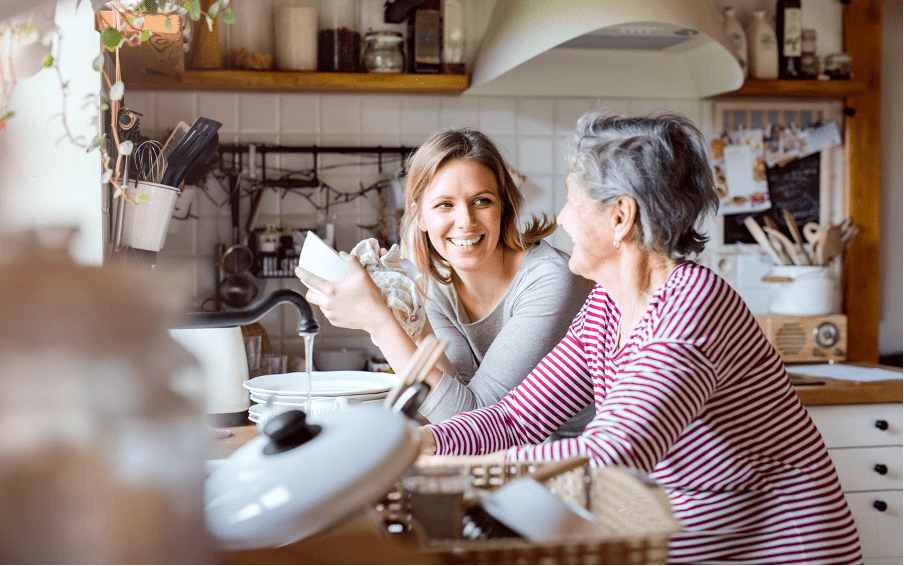Wondering if your elderly parent or partner can stay at home?
As we age, it gets harder to navigate even familiar spaces like home. A well-designed space can help your loved one maintain their independence and dignity. However, accessible design is not one-size-fits-all, and you will need to evaluate each feature against your loved one’s actual needs. Additionally, many “senior-friendly” features often overlook one critical consideration—the caregiver.
If you and your loved one are considering aging in place, here are 6 accessibility challenges you might face and the steps you can take to mitigate them.
Bathrooms.
If your family member needs help with bathing, grooming or using the toilet, can the bathroom accommodate that? For example, a narrow space might prevent you from safely lifting them on or off the toilet. Grab bars are an excellent tool for getting on and off the toilet or in and out of the tub safely. Keep in mind, though, ADA-compliant grab bars may be too high for caregivers assisting in a transfer or for people with minimal upper body strength—you may need to adjust for your particular situation.
Closets.
People with cognitive disorders like Alzheimer’s or dementia often struggle to dress themselves, so streamlining clothing choices is a great way to help them maintain independence. If you have the space, consider removing most of the items and storing them in another location. If your loved one needs additional help, you can select and lay out their clothing for them for the day.
Walkways.
Can your family member safely navigate around the house? About one in three adults over 65 and half of those over 80 will fall at least once a year. Make sure walkways are free of clutter and other trip hazards—throw out those throw rugs! Secure all handrails and repair or remove loose or torn carpet. You may also want to add or upgrade existing light fixtures to ensure your loved one can see clearly as they move around.
Doorways.
Are the doorways and other openings wide enough to accommodate a wheelchair or walker? Structural changes like widening doorways are certainly more costly than something like installing grab bars, but it is possible to make those renovations if you and your loved one are committed to living at home. Doorknobs are also tricky for people with arthritis, so consider replacing them with lever handles.
Stairs.
Stairs are probably the most obvious fall risk. For exterior stairs, you may need to install a wheelchair ramp, which can also be costly. You will certainly want a secure railing on both sides of the stairs that extends beyond the top and bottom step—this is where people are most likely to lose their balance and fall. For interior stairs, the safest option is a stairlift. If that isn’t financially feasible, again, secure the railings and remove any loose fabric like a carpet runner. You can also add nonslip material to hardwood stairs.
Kitchen.
Healthy eating is key for physical health and for memory and mental function. Cooking can also be a great way for seniors to stay engaged and active. However, the kitchen can also be a safety hazard. Does your loved one remember to turn off appliances? Can they safely use a knife? As with other areas in the house, be on the lookout for tripping hazards and remove clutter from counters and other common spaces. You’ll also want to make sure your smoke alarms are installed properly and tested frequently, and you may want to consider automatic shutoff devices for the stove or other appliances.
While some of these changes are simple and inexpensive, others can be quite costly, not to mention space- and time-consuming. If you feel overwhelmed at the prospect of renovating an entire house, assisted living might be a good option for your family.
The Teresa’s House Difference
We designed Teresa’s House intentionally to feel like home while maintaining the highest standards of safety. Each of our three custom communities has 12-16 large private rooms, along with beautifully furnished common areas and an open-concept gourmet kitchen. Each room has its own bathroom with state-of-the-art safety features and a specially designed adaptive closet. We cook and eat fresh, nutritious meals together in our family-style kitchen or the comfortable dining room, and our talented team can prepare made-to-order meals to accommodate any dietary needs. Our intimate scale design is based on years of experience and research into the things that make life comfortable and enjoyable.
Ultimately, we all want to ensure our loved ones live in an environment that fosters their independence while supporting their needs. At Teresa’s House, we focus on the details to create an accessible and safe space that honors our residents’ dignity—just like home, only better.
Sources: Special thank you to Michael Fittz, AIA NCARB, architect & founder of bldg.architecture.


